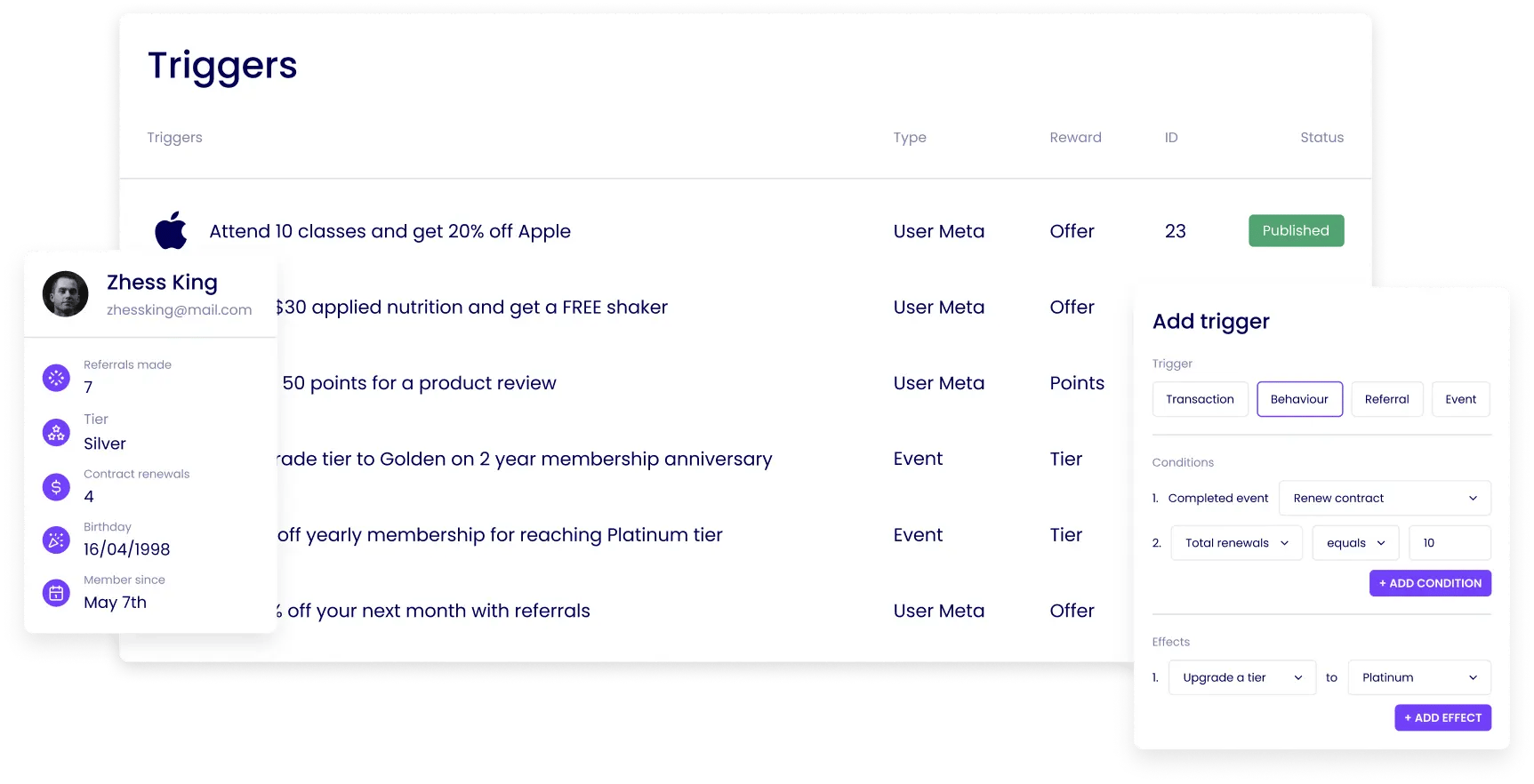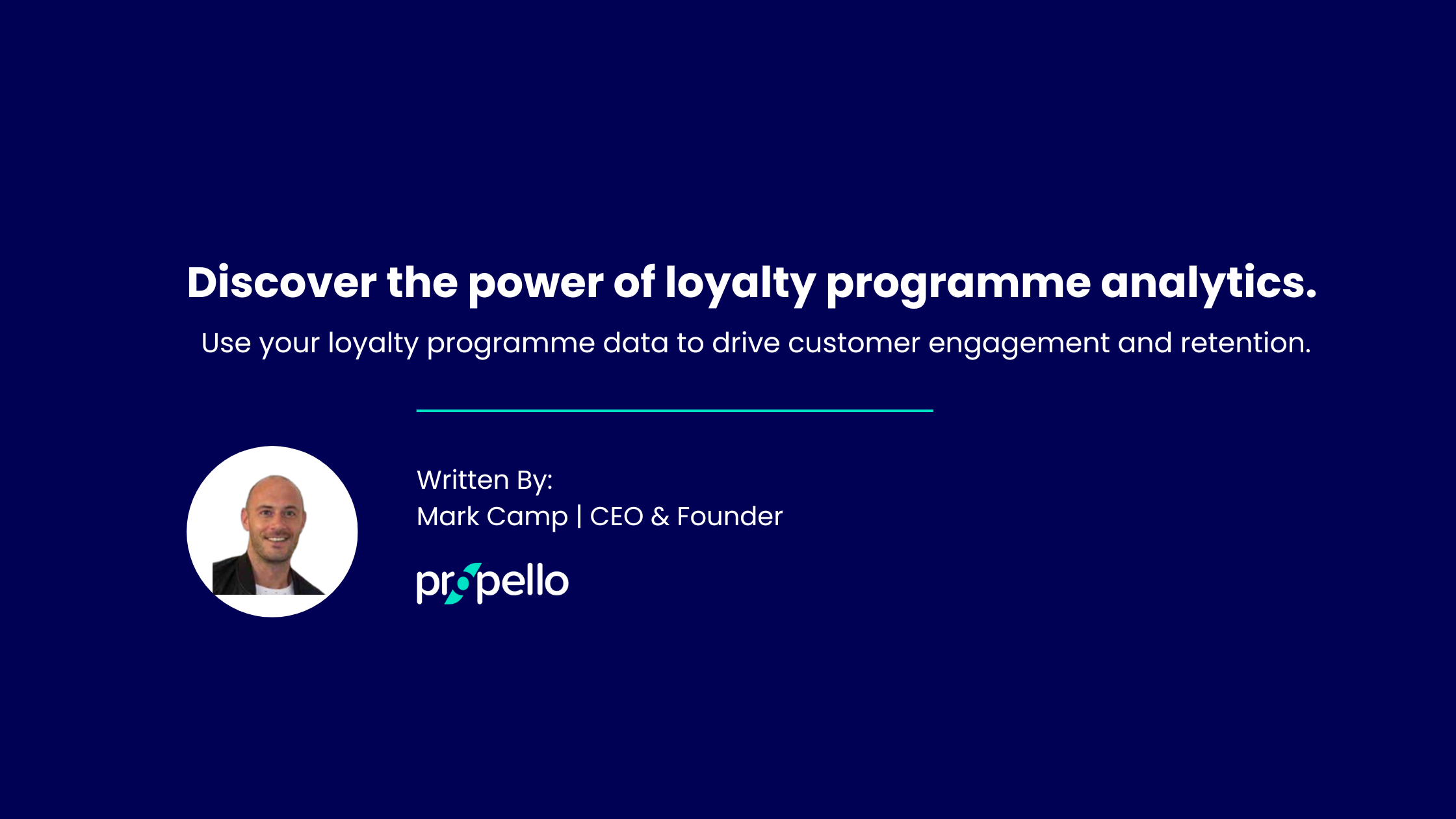In this blog, I’ll explore how loyalty programme analytics can provide you with the holistic picture that you need to craft compelling and personalised customer experiences that can transform your customers into lifelong brand advocates.
Contents:
Key Takeaways
-
Collecting and analysing loyalty programme data helps you gain a deep understanding of what makes your customers tick, enabling you to create personalised experiences that boost customer retention.
-
Identifying your most valuable customers (MVCs) through metrics like customer lifetime value allows you to create targeted campaigns and offer exclusive perks to strengthen their loyalty.
-
Loyalty programme analytics reveal customer sentiment and preferences, helping you address pain points and improve the overall customer experience.
-
Predicting future trends and needs by analysing customer loyalty reveals hidden growth opportunities.
-
Integrating loyalty programme analytics with other systems provides a holistic view of the customer journey, enabling smarter decisions to optimise each touchpoint.
-
While challenges like data quality and privacy compliance exist, investing in the right tools and processes sets your loyalty programme up for long-term success and improved customer retention.
Understanding Loyalty Programme Analytics
You can unravel the mystery of customer loyalty by collecting and analysing data from your loyalty programme. It’s simple and effective. Analytics give you a deep understanding of what makes your customers tick.
Think about it. Every time a customer makes a purchase, leaves feedback, redeems a reward or interacts with your brand, they're leaving behind valuable breadcrumbs of information. Loyalty programme analytics helps you follow those trails to uncover insights that can help you create positive experiences that keep customers loyal.
What kind of insights can you gain from loyalty programme analytics?
Let’s explore the insights you can uncover by digging deep into your loyalty programme data.
Purchase behaviour
By analysing customer transaction data, you can gain a clear picture of what your customers are buying, when they're buying it, and how often. This customer behaviour analysis can guide your marketing efforts and help you make data-driven decisions about everything from product offerings to promotional campaigns.
For example, this purchase behaviour data can be leveraged to cross-sell or upsell a related product or service. Using customer data, conditional reward triggers also encourage a desired customer action such as higher subscriptions in return for a reward.
This shows your customers that you value their business and are committed personalising their brand experience with you.

MVC - most valuable customer
But purchase behaviour is just the tip of the iceberg. Loyalty programme analytics can also help you identify your most valuable customers. Analysing metrics like customer lifetime value and purchase frequency can help you segment your audience and create targeted campaigns that speak directly to the interests of your MVCs.
Offering exclusive perks, personalised recommendations, and VIP experiences to these high-value customers strengthens their loyalty and relationship with your brand.
Customer sentiment
Another powerful insight you can gain from loyalty programme analytics is a deeper understanding of customer preferences and sentiment. Data from customer feedback, social media interactions, and other touchpoints can tell you how your customers feel about your brand, products, and services.
You might discover that customers feel frustrated with the redemption process or find the reward options unappealing. You can then take steps to address these pain points, improving the customer experience and your chances of acquiring new customers.
Growth opportunities
But perhaps the most exciting thing about loyalty programme analytics is the ability to uncover hidden opportunities for growth and innovation. By analysing customer behaviour and preferences over time, you can identify emerging trends and anticipate future needs.
For example, you might notice that a growing number of customers are redeeming their rewards for eco-friendly products or experiences. With this insight, you could expand your offerings to include more sustainable options or even launch a new product line to attract potential customers.
Back to contents
What are the Benefits of Leveraging Loyalty Programme Analytics?
Increased customer lifetime value (CLV)
One key benefit of using loyalty programme analytics is the potential to increase customer lifetime value (CLV). Analytics provide insights that allow you to serve customers better and strengthen their emotional connection to your brand.
A customer's lifetime value increases by 306% when they develop an emotional connection to a brand.
Improved customer engagement
By leveraging customer engagement analytics, you can create a loyalty programme that not only rewards your customers but also keeps them engaged. Actively engaged customers make 90% more purchases, spend 60% more per transaction, and are more likely to choose the brand again.
Improved customer experience
By analysing customer behaviour patterns and their preferences, you can identify areas where you can improve the overall customer experience. For some, this might mean creating dedicated customer service teams or even revisiting reward structures.
Reduced customer churn
Another key advantage of loyalty programme analytics is the ability to identify and reduce customer churn. By keeping a pulse on customer satisfaction scores and analysing feedback, you can spot potential issues before they escalate and take steps to address them. This proactive customer churn analysis can help you hold onto loyal customers.
Increased programme ROI
But perhaps the most compelling reason to embrace loyalty programme analytics is the potential for increased ROI.
By focusing your efforts on your most valuable customers and creating personalised experiences that keep them engaged, you can boost loyalty programme ROI and long-term growth for your business.
Back to contents
Differences Between Loyalty Analytics and Retention Analytics?
Either as a stand-alone loyalty programme or through integration into other data platforms such as CRMs, loyalty and retention analytics can be derived from your loyalty solution. Both provide data to facilitate better customer relationships and experiences but the approach between the two have some nuances.
|
Aspect |
Customer Loyalty Analytics |
Customer Retention Analytics |
|
Focus |
Customer behaviour across the entire customer journey |
Specific factors contributing to customer retention |
|
Data Scope |
Holistic view of customer interactions and preferences |
Narrower focus on retention-related metrics |
|
Data Sources |
Loyalty programme data, purchase history, customer interactions, etc. |
Customer lifetime value, churn rate, customer satisfaction scores, etc. |
|
Insights |
Trends, patterns, and preferences that drive customer loyalty |
Factors that contribute to customer churn and retention |
|
Predictive Capabilities |
Uses data to predict future customer behaviour and trends |
Primarily focuses on analysing historical data to identify patterns |
|
Goal |
Creating personalised experiences to increase customer loyalty |
Identifying and preventing customer churn |
|
Approach |
Proactive, predicting customer needs and preferences |
Reactive, addressing issues that may lead to customer defection |
|
Outcome |
Increased customer loyalty, engagement, and lifetime value |
Improved customer retention rates and reduced churn |
|
Benefit |
Builds long-term, profitable customer relationships |
Helps maintain and protect existing customer relationships |
Perhaps the biggest difference between loyalty programme analytics and retention analytics is their predictive capabilities.
Loyalty analytics isn't just about understanding past behaviour - it's about using that data to predict future trends and anticipate customer needs. By analysing customer data over time, you can identify patterns and trends that help you stay one step ahead.
Maybe you notice that customers who buy a certain product are more likely to make a repeat purchase within a certain timeframe. With this insight, you can create targeted campaigns that encourage them to come back and shop again.
Retention analytics, on the other hand, is more focused on analysing historical data to identify patterns and trends that have already happened. While this can be valuable for identifying areas for improvement, it doesn't necessarily help you predict future behaviour.
By combining the holistic view of loyalty analytics with the laser focus of customer retention metrics, you can create a powerful strategy for building long-term, profitable customer relationships.
Back to contents
How to use Loyalty Programme Analytics: The Process
Let’s discover how data-driven insights can help you create more meaningful connections with your customers. Let's break down the process step by step.
Analyse and segment customer data
Gather customer information from your loyalty programme and integrated data solutions - from transaction histories, reward redemptions, customer lifetime value and demographics. The key is to paint a comprehensive picture of who your customers are and what makes them tick.
One way to make sense of all this data is by segmenting your customers into distinct groups based on shared traits and behaviours. This can help you spot patterns and trends that might otherwise go unnoticed.
For instance, you might find that a certain segment of the customers surveyed want experiential rewards, while another group prefers cold, hard cash. Armed with this knowledge, you can tailor your loyalty programme to offer the right mix of incentives for each type of customer.
Personalise rewards and offers based on data
But why stop at segmentation? The real magic happens when you start personalising your loyalty programme down to the individual level.
Leverage customer data to create tailored recommendations, exclusive offers, and customised communications. You’ll be encouraging customers to engage with the programme and remain loyal to your brand.
Success in personalisation leads to a 6.4x increase in programme satisfaction among members.
Monitor key metrics for programme optimisation
But the journey doesn't end there. To truly maximise the impact of your loyalty programme, you need to embrace a culture of continuous improvement. That means regularly tracking your programme's performance, gathering customer feedback, and using those insights to drive loyalty programme optimisation.
It’s also important to track other useful metrics alongside loyalty programme metrics. Tracking your Customer Effort Score (CES), for instance, gives you a more comprehensive understanding of the customer experience and helps you identify areas for improvement.
You can analyse the relationship between CES and other loyalty programme metrics, such as redemption rate, engagement rate, or customer satisfaction score. If you notice that customers with high CES tend to have lower engagement or redemption rates, it might suggest that the effort required to participate in your loyalty programme is negatively impacting its effectiveness.
Integrate with existing systems
Your loyalty programme should seamlessly integrate with your other customer-facing systems, like your CRM, POS, and marketing automation tools, as it does not exist in a vacuum. By bringing all that data together in one place, you can gain a more holistic view of your customers and make smarter decisions about how to engage them.
Keep the customer journey front and centre
At the end of the day, your loyalty programme is all about creating a better experience for your customers. That’s when you need customer journey mapping.
By mapping out the customer journey from start to finish and identifying key moments of truth along the way, you can use data to optimise each touchpoint and create more seamless interactions.
Back to contents
Challenges and Limitations of Loyalty Programme Analytics
While customer loyalty analytics can be a game-changer for your customer engagement, loyalty and retention efforts, it's important to be aware of the potential roadblocks you might face along the way. Here are some of the most common challenges and limitations to keep in mind:
-
Data quality and integration issues.
-
Ensuring data privacy and security compliance.
-
Overcoming data silos and fragmented systems.
-
Dealing with unstructured data like customer feedback and social media interactions.
-
Attributing revenue and ROI to specific loyalty programme initiatives.
-
Balancing personalisation with scalability and efficiency as the total number of customers in your programme increases.
-
Keeping up with rapidly evolving customer expectations and market trends.
Back to contents
Ready to unlock the full potential of your customer data?
Customer loyalty programme analytics – a critical tool for driving success in today’s business landscape – really comes into its own by using data to personalise experiences, maximise performance and deepen customer relationships.
So, if you're planning a customer loyalty programme, or if you're looking to revamp your existing programme to leverage customer data better, book your discovery call with us.
FAQs
Q1. What are loyalty programme analytics?
Loyalty programme analytics involve analysing customer behaviour to improve customer loyalty. By analysing how customers interact with rewards, businesses can tailor their offerings to better align with customer expectations. This creates a stronger sense of loyalty and encourages continuous brand support.
Q2. How can loyalty programme analytics increase customer retention?
The insights that businesses derive from analysing customer interactions enable them to personalise experiences more effectively, which makes customers feel valued and appreciated. This personalised approach leads to higher retention rates by reinforcing the customer's connection to the brand.
Q3. What key metrics should businesses use to measure customer loyalty?
In measuring customer loyalty, pivotal metrics include the Net Promoter Score (NPS), repeat purchase rate, and customer satisfaction score. These indicators provide a comprehensive view of how deeply customers are committed to the brand, showing the effectiveness of loyalty strategies and areas needing improvement.
Q4. Why is understanding purchase behaviour crucial in loyalty analytics?
Understanding purchase behaviour helps businesses identify and reward dedicated customers for their loyalty, thereby promoting repeat purchases. This strategic focus on rewarding loyalty not only encourages continued business but also transforms passive customers into passionate brand advocates.
Q5. How does customer feedback influence loyalty programme strategies?
Customer feedback plays a big role in shaping loyalty programme strategies by offering unfiltered insights into customer preferences and satisfaction levels. Taking this feedback into account in loyalty programmes ensures they remain relevant and effective, thereby enhancing customer satisfaction and loyalty.
Q6. Can analysing customer segments improve loyalty programmes?
Analysing customer segments can substantially improve loyalty programmes by creating more customised and effective communication and rewards. This targeted approach ensures that loyalty initiatives resonate more deeply with diverse customer groups, thereby increasing engagement and loyalty across the board.
Q7. What role does the customer retention rate play in loyalty analytics?
The customer retention rate, a key metric in loyalty analytics, reflects the effectiveness of a loyalty programme in maintaining customer engagement over time. A high retention rate indicates a well-crafted loyalty programme that successfully keeps customers engaged, serving as a testament to its effectiveness.
Q8. How can businesses use loyalty analytics to reward customers?
Businesses can leverage loyalty analytics to identify and subsequently reward their most engaged customers with personalised incentives such as special offers or exclusive benefits. This strategic use of analytics not only cultivates customer loyalty but also encourages a continuous cycle of engagement and loyalty.
Q9. What is the significance of the repeat purchase rate in loyalty programmes?
The repeat purchase rate is a crucial indicator within loyalty programmes, revealing how often customers return for additional purchases. A high repeat purchase rate signals a loyalty strategy's success in motivating customers to continue their patronage, thereby indicating strong underlying loyalty.
Q10. How can loyalty analytics help to improve customer experiences?
Loyalty analytics help elevate customer experiences by offering detailed insights into individual preferences and behaviours. With this knowledge, businesses can tailor their services and interactions to better meet customer needs, thereby significantly enhancing overall satisfaction and fortifying customer loyalty.
Author Bio, Written By:
Mark Camp | CEO & Founder at PropelloCloud.com | LinkedIn
Mark is the Founder and CEO of Propello Cloud, an innovative SaaS platform for loyalty and customer engagement. With over 20 years of marketing experience, he is passionate about helping brands boost retention and acquisition with scalable loyalty solutions.
Mark is an expert in loyalty and engagement strategy, having worked with major enterprise clients across industries to drive growth through rewards programmes. He leads Propello Cloud's mission to deliver versatile platforms that help organisations attract, engage and retain customers.



.png)